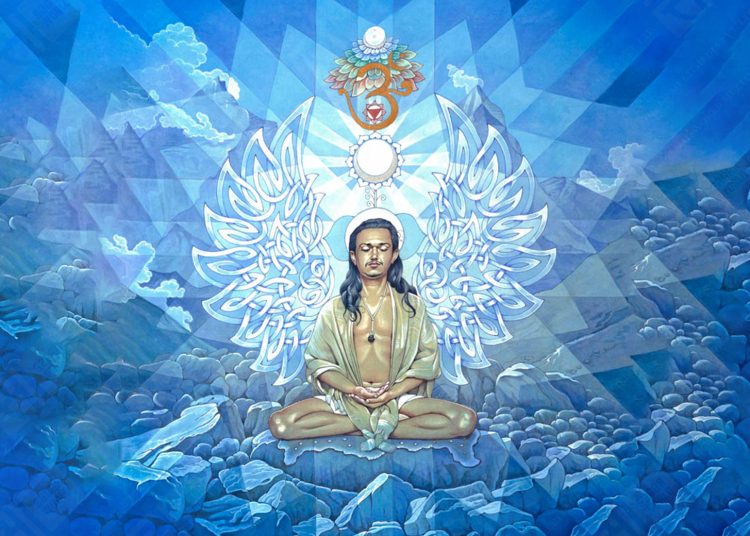
Rudra Granthi Mandala Painting – Invoke Lord Rudra
Hinduism worships Rudra, a deity who is seen as a ferocious and strong manifestation of Lord Shiva. He is frequently portrayed as a hunter, a ferocious warrior, the Lord of Beasts, and a defender of the wild. He is linked to hunting and storms as well. Rudra was revered as the god of storms and hunting throughout the Vedic era. He is also linked to the Maruts, a collection of storm gods. Shiva, one of the most significant gods in Hinduism, was Rudra’s ancestor in later Hindu mythology. He is revered as the demolisher of the ego, the god of yoga and meditation, and the embodiment of the soul’s eternal oneness alongside the divine. One of the main Hindu religions that places a strong emphasis on the worship of Lord Shiva is known as Shaivism, and Rudra is the god of that tradition.
The phrase “Rudra Granthi” refers to a particular part of the human anatomy, particularly the region between the eyebrows, commonly referred to as the “third eye” or Ajna chakra. It is regarded as the source of spiritual wisdom, intuition, and insight. Practitioners of yoga and meditation frequently direct their attention to this spot during their activities.
It is also stated that Lord Rudra, who is regarded as one of the ferocious forms of Lord Shiva, is the one who may assist in removing these knots and assist in opening the third eye. Rudra Granthi is thought to be the site of karmic knots that obstruct spiritual advancement.
Lord Rudra, who is seen as a strong and potent manifestation of Lord Shiva, is shown in the classic Hindu painting known as the Rudra Granthi Mandala. The mandala, or sacred geometric pattern, is a device for meditation and Lord Rudra invocation.
It is thought that one can invoke Lord Rudra’s blessings and gain spiritual guidance and protection by concentrating on the image and repeating mantras that are dedicated to him. The picture is frequently utilised during puja (worship) ceremonies and is typically found in temples and the houses of Lord Shiva worshippers.
A Rudra mandala is a geometric design that symbolises the Hindu deity Lord Rudra, who is viewed as a ferocious and strong version of Lord Shiva. The mandala is a tool for meditation and Lord Rudra invocation. It is frequently utilised during puja (worship) rituals and is commonly found in temples and the houses of Lord Shiva followers.
The mandala typically includes a core circle or square and radiating lines that symbolise Lord Rudra’s cosmic vitality and connection to the cosmos. Additionally, Lord Rudra-related symbols and mantras like the trident and “Om Namah Shivaya” may be incorporated into the design (I bow to Lord Shiva). It is thought that the Rudra mandala has the ability to both bless and Defend the devotee and aid in spiritual development.
The Rudra mandala is thought to have a number of spiritual advantages, including:Protection: Lord Rudra is seen as a strong defender, and devotees who focus on the Rudra mandala and recite mantras to him may experience a sense of safety and protection.
Obstacles can be eliminated by concentrating on the Rudra mandala since Lord Rudra is reputed to be able to do so. This can help to rid the body and mind of harmful effects.
Intuition and spiritual understanding are thought to reside in the third eye, also known as the Ajna chakra, which is connected to the Rudra mandala. The Rudra mandala can help one develop their spiritual understanding and knowledge via meditation.
Lord Rudra is also known for curing diseases, therefore meditating on the Rudra mandala may aid in bringing about both physical and emotional healing.
Lord Rudra is known as the killer of ego, therefore meditating on the Rudra mandala may aid to bring serenity and tranquillity by eradicating the ego and facilitating a connection with the divine.
Power and energy: Lord Rudra is a powerful deity, and using the Rudra mandala to invoke his energies can give you a boost of both.
It’s crucial to remember that the advantages of meditation and praying to a deity depend on the habits and beliefs of the individual, and that each person may have different outcomes.
The Artist – Pieter Weltevrede
Pieter Weltevrede – is a Master “Sacred-Artist” based out of the Nederlands. After a many years of guidance, under his guru Late Harish Johari a successful author, a gifted painter and sculptor, a lifetime scholar, an inspiring teacher, a splendid cook, an ayurvedic massage miracle, etc., Pieter embarked on his own journey amalgamating ancient Indian knowledge with his own western sensibilities evolving an art form that appeals to todays international audience. He has been practising his art form from the last 40 years now.
His original paintings are in water colours on silk with a wash-technique that gives them a very three-dimensional feel. The complexity and detail in his works are a super-human endeavour as he continues to live a mundane life travelling between the Western World and India.
Here, ‘Goddess Saraswati’ paintings are printed on coated matt paper.
Click Here to visit our Shop Site.








